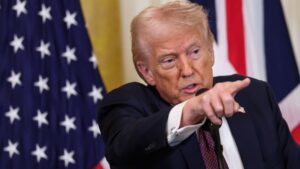The New Reality of Market Support: Understanding the "White House Put" and Its Implications for Investors
For decades, savvy investors have relied on the proverbial "Fed put," an implied safety net that the Federal Reserve would step in to support markets during downturns. However, as we navigate today’s increasingly complex economic landscape, another form of market support is emerging: the so-called "White House put." This term, popularized by market strategists like Tom Lee and Michael Hartnett, suggests that fiscal stimulus from the executive branch could act as a buffer against market weakness, especially when tariffs and other policies threaten economic stability.
The Concept of a "White House Put"
In his latest market notes, Tom Lee, head of research at Fundstrat Global Advisors, articulated that the current administration aims to prevent the economy from reaching “stall speed”—a term used to describe a slowdown that raises recession risks. According to Lee, should the economy approach this precarious situation, the likelihood of fiscal stimulus increases. In essence, a "White House put" implies that as markets falter, we might see swift intervention from the government, reminiscent of how the Fed has historically acted.
But what’s new here at Extreme Investor Network is the proactive approach we advocate for in light of these dynamic circumstances. Understanding economic signals and preparing for potential fiscal maneuvers can help you position your portfolio advantageously.
Current Economic Landscape: Tariffs and Consumer Sentiment
Recent consumer surveys indicate growing anxiety about the implications of the administration’s economic policies. As inflation fears rise, it has not gone unnoticed that bond yields are experiencing downward pressure, which reflects increasing concerns about potential recession-like conditions. This uncertainty is prompting many investors to reassess their strategies.
The first quarter of the year is often a litmus test, and recent data—such as the Atlanta Fed’s GDPNow tracker indicating a contraction of 1.5% due to lowered consumer spending—has raised eyebrows. It’s a reminder that in today’s world, the interconnectedness of fiscal policies and market performance cannot be overlooked.
Are Interest Rates About to Change?
Aside from potential fiscal measures, the Federal Reserve appears to be on the cusp of a more dovish approach. With the markets teetering on the brink of a slowdown, the Fed might signal a readiness to lower interest rates. This situation creates a very interesting scenario for long-term investors.
Lee mentions that tariffs could lead to further weakening of economic growth and might even suppress inflation levels, prompting the Fed to take a more accommodating stance. This interplay between tariffs and monetary policy could provide unique trading opportunities that discerning investors should be prepared to exploit.
The “Trump Put” and Market Positions
Hartnett’s analysis offers additional insight into market positioning. He identifies a "1st strike price" for the "Trump put" at 5,783 for the S&P 500—just 1.3% below recent closes. This figure is significant, not only because it represents a potential support level but also because it echoes the market sentiment surrounding Trump’s policies in the lead-up to the 2024 elections.
Should the S&P 500 breach this threshold, we may witness increasing calls for verbal support from policymakers—a phenomenon that Extreme Investor Network is monitoring closely. Such statements could significantly influence market psychology and investor behavior.
What This Means for You as an Investor
While navigating this unpredictable landscape, here are actionable insights to consider:
-
Stay Informed: Keep an eye on fiscal policy changes and Federal Reserve communications. Understanding the nuances of these decisions will empower you to make informed choices.
-
Diversify Your Portfolio: Given the volatility associated with tariffs and other political developments, consider diversifying your investments across various asset classes to mitigate risks.
-
Leverage Tools and Resources: Utilize market analytics and data from reputable sources like Extreme Investor Network to gauge market direction and pivots. Staying well-informed is your best defense against uncertainty.
- Engage with Expert Opinions: Regularly consult market analysts and financial advisors who can provide deeper insights into these policies and their broader implications for your investment strategy.
In conclusion, as we look to the future, understanding the evolving landscape of economic support—from "Fed puts" to "White House puts"—will be essential for navigating turbulent markets. Here at Extreme Investor Network, we are committed to providing you with the insights needed to make smart investment decisions in this complex environment. Stay connected with us for the latest updates and strategies that will give you an edge in your investing journey.

